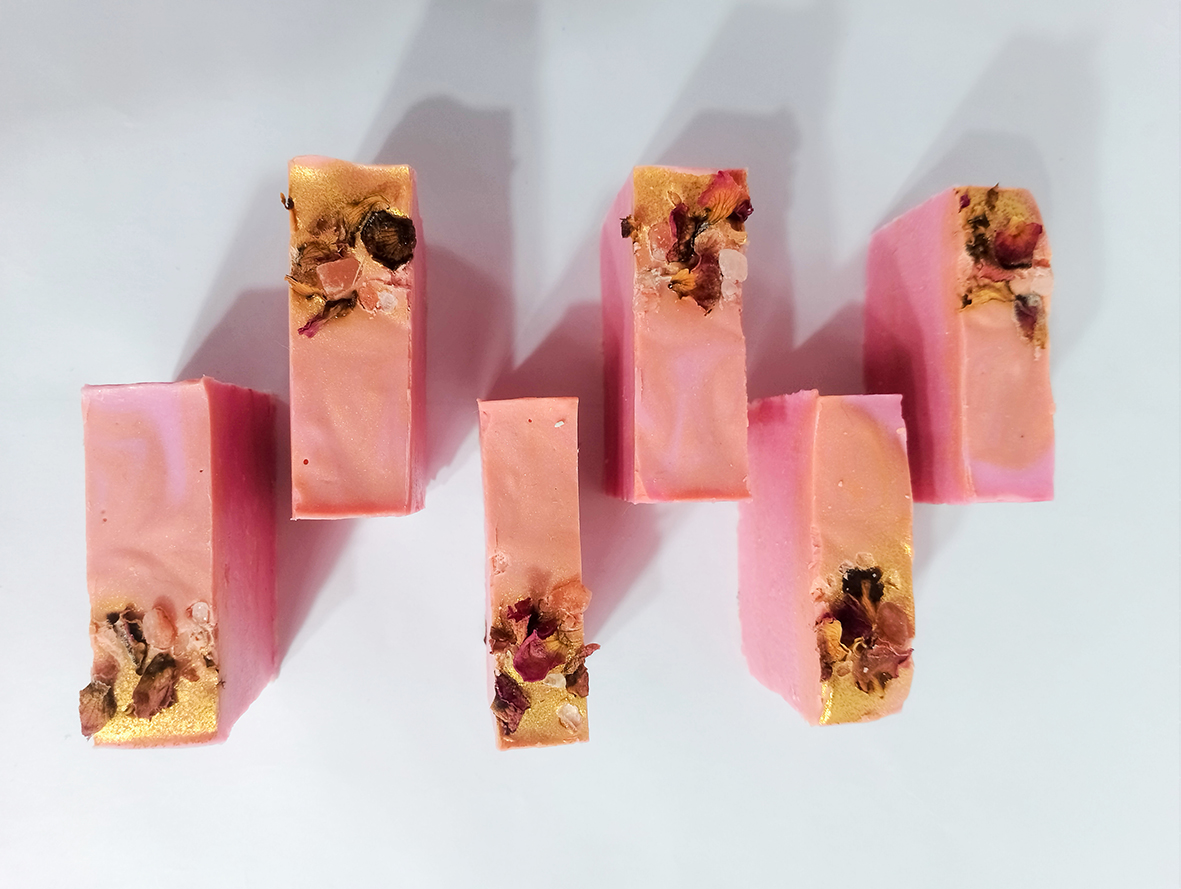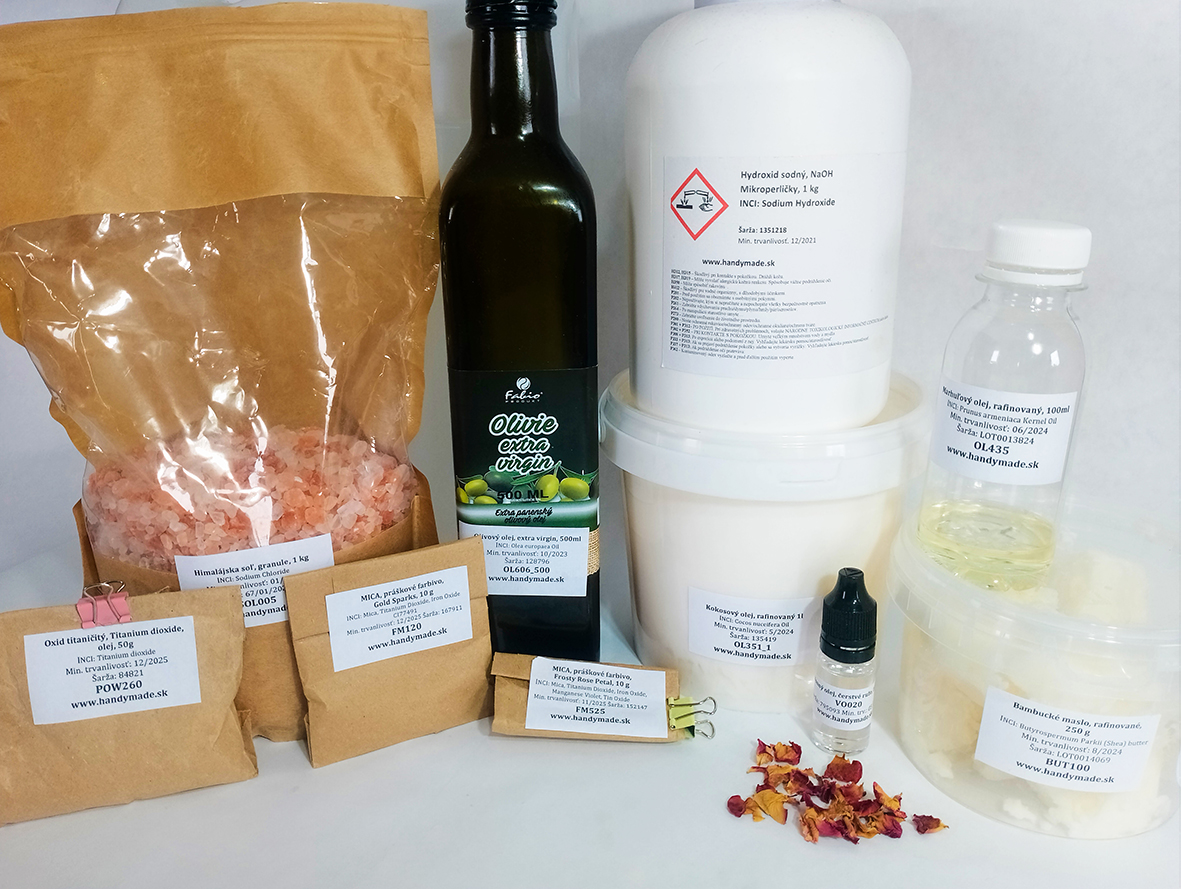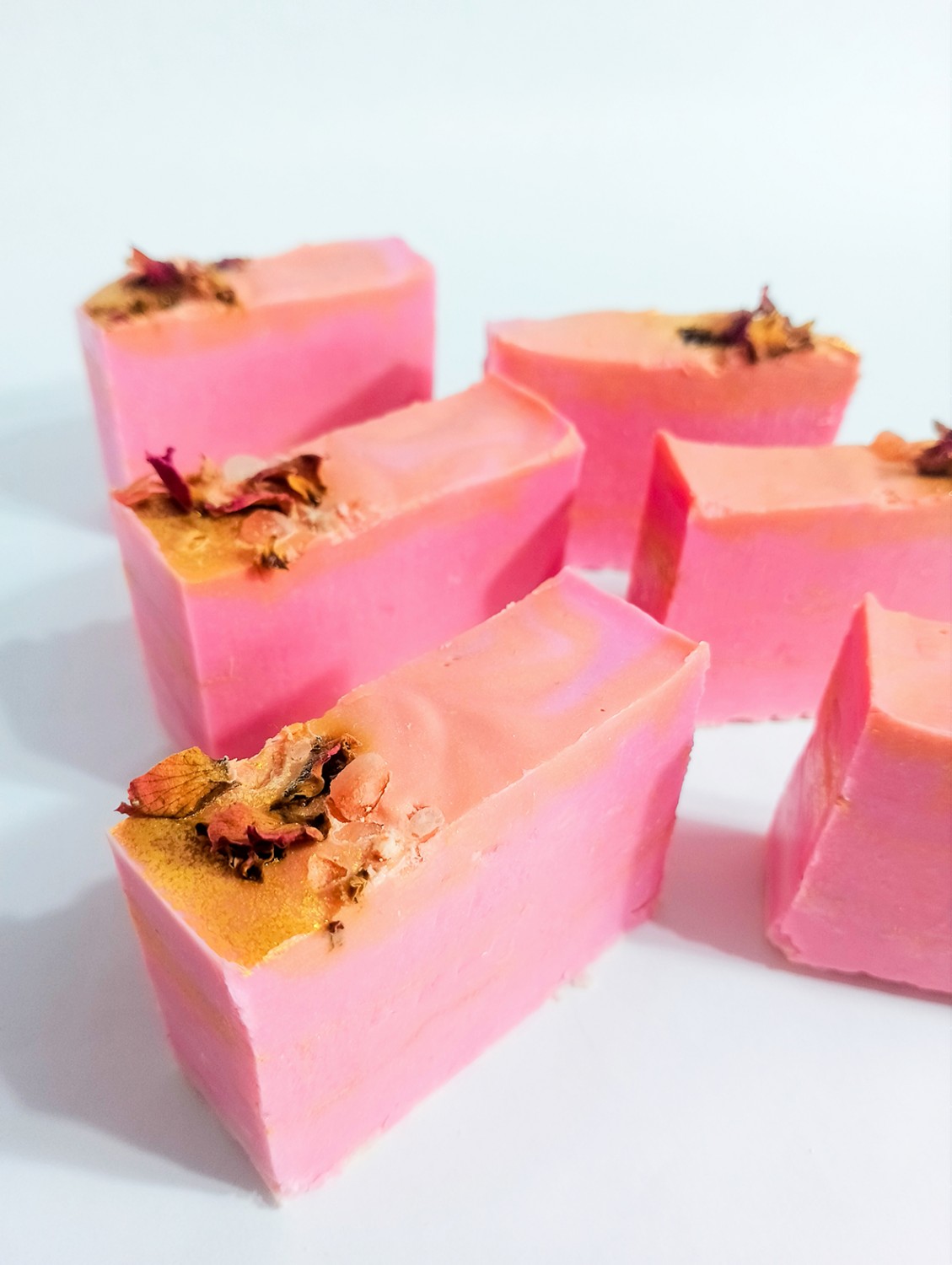Pink soap for beginners
Make pink soap with us. Even beginners can do it.
Have you always wanted to try making homemade cold process soap, but it always seemed too complicated? Here are detailed instructions for making pink soap, which you can decorate and flavour to suit your taste.or make it even easier and skip the Himalayan salt and rose petals decoration altogether.

PINK SOAP FOR BEGINNERS - INGREDIENTS
To make cold process soap, we always need sodium hydroxide and demineralised water. Do not use tap water - because of the minerals, the chemical reaction of soap formation is disturbed. Other essential raw materials are oils and butters.
We have prepared a ready-made recipe for you, but any confusion regarding oils or butters will result in
will result in a change in the amount of hydroxide and water required. For this reason, the quantity of ingredients is given in grams. If you insist on changing the recipe, it must be recalculated using a soap calculator (many freely available online). 400 g of oils and butters have been used in the recipe.
INGREDIENTS m (g)
Demineralised water 111,00
Sodium hydroxide 55,50
Olive oil 180,00
Apricot oil refined 40,00
Coconut oil refined 100,00
Shea butter refined 80,00
Mica powder Frosty Rose Petal 2,00
Titanium dioxide oil 5,00
English Rose Fragrance Oil 12,00
Isopropyl alcohol - IPA as required
Himalayan coarse grained salt as required
Rose petals as required
Mica powder Gold sparks as needed

PINK SOAP FOR BEGINNERS - PROCEDURE
1.put on gloves, goggles, long sleeved clothing. Work in a well-ventilated room (hydroxide vapors are harmful) with stainless steel or plastic containers or chemical/cooking glass.
2. weigh the necessary amount of water. Weigh the sodium hydroxide into a second container.
3. sieve the sodium hydroxide into the water in small batches, stirring constantly. The mixture will heat up intensely, so you can also cool it in a container of cold water. After all the hydroxide has been mixed in, allow the mixture to cool to 36-38 °C.
4.in a heatproof container, weigh out all the oils and butters, start heating gently until the butters are melted. Allow the mixture to cool to 36-38 °C. Take approximately a tablespoon of the oils at a time
and mix the oil with the mica powder and, in a separate container, with the titanium dioxide.
5.when both the hydroxide solution and the mixture of oils and butters have reached 36-38 °C, pour the hydroxide solution (ideally through a plastic/stainless steel strainer) into the oils and mix well. Add the fragrance oil. Then start mixing with an immersion stick blender and add the titanium dioxide oil mixture followed by the mica powder. Mix until the mixture reaches the "trace" stage (about the consistency of pudding).
6. pour the mixture into the mould, spray the surface with IPA.
7.optional - to decorate the soap, sprinkle one of the longer edges with golden mica powder through a sieve. Then decorate this sprinkled area with dried rose petalsand a little Himalayan salt.
8. cover the finished soap mould with cling film, wrap in a blanket and place in a warm place.
9. after about 1 week, the soap is ready to cut (if it seems too soft, let it sit for a few days).
10. allow the soap to mature for at least 6-8 weeks before using, then check the pH with litmus papers (moisten the surface of the soap with distilled water before attaching the paper). The ideal pH is 9-10, do not use soap with a higher pH or uneven pH (there are areas of different pH in the soap).
PINK SOAP FOR BEGINNERS - TIPS AND TRICKS
Below you will find some tips and tricks to make your soap making easier or avoid some mistakes.
Always use protective equipment, especially gloves and goggles, when working with hydroxide and unripened soap (i.e. soap that has not been aged for at least 6 weeks). If skin is affected, wash the area immediately with cold water or use diluted vinegar for further rinsing. Also use diluted vinegar to clean surfaces after work (the acetic acid neutralises the hydroxide residue) and place all the equipment and containers you have used in the diluted vinegar for a few minutes before washing them.
When the hydroxide dissolves in the water, a large amount of heat is generated. You can therefore replace about half of the water with ice, also made from demineralised water. The solution will cool down faster. It is a good idea to pour the finished solution into the oil mixture through a sieve, as this may trap any undissolved hydroxide granules.
The mixture of oil and mica powder or titanium diox ide should also be added through a sieve to catch lumps of unmixed dye, giving your soap a uniform colour.
Use a plastic or stainless steel stick blender when mixing the soap. Ordinary metal will oxidize due to the hydroxide.
Spraying your soap with IPA is advisable to prevent soap dust (a white layer on the surface of the soap), but it is not necessary, soap dust is only an aesthetic defect.
You can also use phenolphthalein solution or papers containing phenolphthalein to control the pH. When using phenolphthalein papers, follow the same procedure as with litmus papers, the papers should not turn pink. If you use a solution, drop it on different parts of the soap, it should not turn pink in the same way. A pink color indicates high pH values and thus unreacted hydroxide, such homemade soap is not safe to use.
To create golden veins in the soap, you can first pour only part of the soap into the mould, then sprinkle the surface with golden mica powder (through a sieve) before adding the rest of the soap.

PINK SOAP FOR BEGINNERS - INGREDIENTS AND THEIR IMPORTANCE
Below we will present the individual raw materials for making pink soap for beginners, their variations and properties.
DEMINERALISED WATER
Demineralised or distilled water is always used for the production of cold process soaps. Only this water is free of minerals, so there is no risk of unwanted reactions of these minerals with sodium hydroxide.
Also for this reason, do not use boiled water or tap water.
SODIUM HYDROXIDE
Hydroxides are necessary for the production of soaps. Sodium hydroxide provides solid soaps, on the other hand, potassium hydroxide will be used in the production of liquid soaps, do not confuse it with sodium hydroxide without reading the recipe.
Sodium hydroxide is a strongly alkaline substance, so always use protective equipment when working with it. Keep hydroxide out of the reach of children and pets, as well as its solution or raw, unripened soap.
OIL
A popular base oil for soap making is olive oil. This oil is readily available and can therefore be found in many soap recipes. It provides mild soaps with nourishing properties. It can be substituted for other vegetable oils, but then it is always necessary to recalculate the recipe.
MARGARIAN OIL
Apricot oil is rich in vitamins and minerals. It is light in colour and so does not interfere with the shades of added colourings. It is well absorbed by the skin and therefore has universal use in many kinds of recipes. The same rules apply when substituting it as for olive oil.
COCONUT OIL
Coconut oil is useful for obtaining a hard and faster setting soap. Although it is an oil, this fat is solid at room temperature, so it is ideally combined with vegetable butters to add strength, foaminess
and hardness to soaps.
BAMBUCK BUTTER
You'll love the nourishing vegetable butter when making soaps because the resulting soaps will have a soft, creamy lather, but will also be hard and durable enough to last . Along with cocoa butter, shea butter is one of the most commonly used butters for soap making, and not just because of its properties,
but also its affordability.
A refined version will suffice for soap making, as the fatty acids from this butter will react with sodium hydroxide anyway.
MICA POWDER
Mica powders are popular for colouring soaps because of their high stability even in alkaline pH. Mica powders will give you soaps with stable color and some with a slight sheen. When adding them to soap, it is advisable to mix them with a little oil and add through a strainer so that lumps do not form.
There is a really wide variety of mica powders to choose from, so feel free to use your imagination.
Alternatively, you can omit the mica powder altogether.
TITANIUM DIOXIDE
Titanium dioxide is used to accentuate the added colourings. This strong white powder helps to lighten the soap slightly, so you use less of the other colouring agents to achieve the desired colour result.
It is also advisable to add titanium dioxide through a sieve so that lumps do not form, and to choose a type that is suitable for combining with oils. If you do not have titanium dioxide, feel free to omit it and increase the dose of mica powder by about 0.5 g.
FRAGRANT OIL
Fragrance oils are often usedto flavour soaps because they are light in colour and so do not affect the final colour of the soap. You can also use essential oils, but some of the darker coloured oils can discolour the soap. Fragrance or essential oils are often added in excess because some of them will react with the hydroxide.
ISOPROPYL ALCOHOL - IPA
As mentioned, isopropyl alcohol helps prevent soap scum. You can also use it after cutting the soap - spray the fresh cut with IPA to help the soap harden faster and not form soap dust.
HIMALAYSIAN SALT
Pink Himalayan salt is great for embellishing your soap. You can opt for the coarse-grained version (it's a good idea to press the crystals into the soap lightly when decorating so they don't fall out when they harden) or reach for the finely ground version. You can also decorate the soaps with classic sea salt or other ingredients.
PINK CHIPS
Dried flowers or herbs are a popular material for decorating soaps. You can choose from a wide variety of different plants to decorate your soaps with. However, it is a good idea to remove the wet chips from the soap after the first use, or to let the soap dry thoroughly (do not leave it in contact with water, for example in a soap dish) so that the chips do not mould.
NOTICE
As mentioned, you can experiment with homemade recipes to achieve the desired properties. However, many factors such as humidity, temperature, quality of ingredients and storage can affect the final result.
Before using any raw material to make a cosmetic product, familiarize yourself with its properties, recommended dosage, storage conditions or safe handling. Any raw material may have the potential to cause an allergic reaction in sensitive individuals, so before using a product, we recommend that you find out if you suffer from an allergy to any of the raw materials or the overall product, e.g. by a skin test.
If you have very sensitive or very acne-prone skin, or other skin and health problems, we recommend that you consult a medical professionalbefore applying a new product to your skin, whether it is a homemade cosmetic product, a pure raw material or a commercially available product.
PINK SOAP FOR BEGINNERS - CONCLUSION
Is there any beginner who has succeeded in making pink soap? If you have tried it and are already enjoying the fruits of your labour, be sure to show off and show us your work on social media or send it to us at marketing@handymade.sk
All your mails will be appreciated.
Thank you very much to Ivana Jačalová for the great tutorial on pink soap making and the nice photos.
Do you have an idea for another tutorial or are you missing one? Write to us and let's inspire each other.
Until then, goodbye, my friends.


